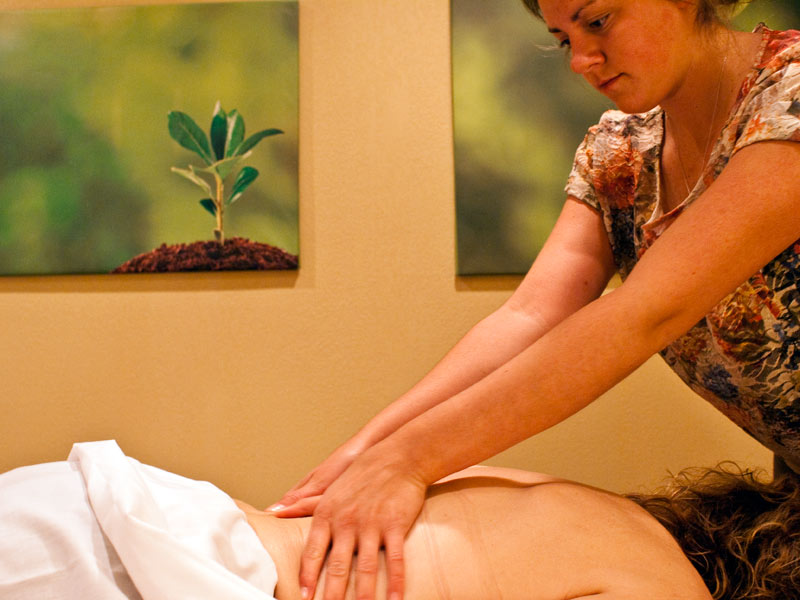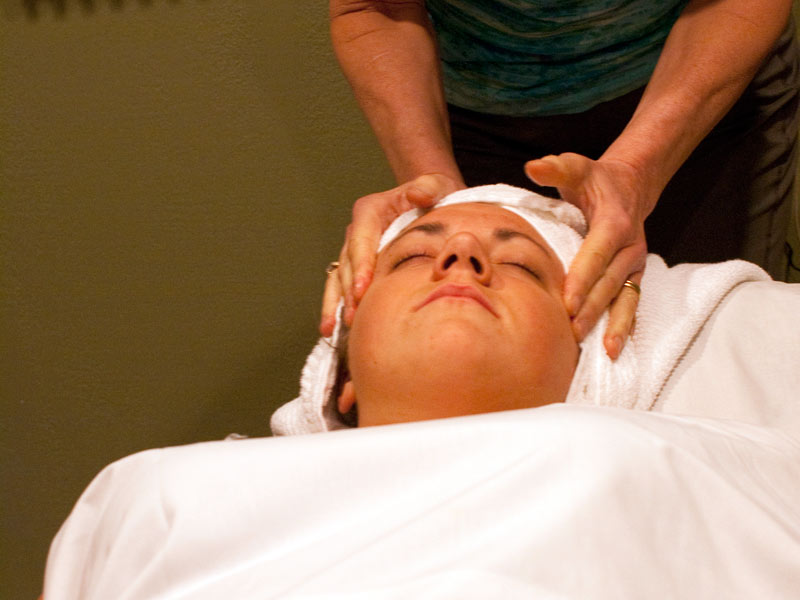Are you one of thousands of people seeking pain relief? Are you tired of living with a bad back, sore neck, stiff shoulder or bum hip? Have you tried doctors, medications, traditional and non-traditional therapies with some success, but the problem keeps recurring? You’re not alone. We understand this cycle, and that’s why our clients come to us. At Meridian Healing Center, we take a holistic approach to chronic pain relief and pain management that goes beyond a standard massage.
Our highly specialized therapists are dedicated to the relief of all pain-related conditions through their wide array of techniques and training. By utilizing stretching and strengthening exercises, trigger point therapy, deep tissue bodywork, acupressure, massage, manual therapies and more, our therapists have fine tuned their skills to successfully treat both chronic and acute painful conditions. This unique approach goes much further than just a standard massage and includes an analysis of risk factors unique to each individual. This includes workplace/ home environments, lifestyle and nutrition, and analyzes other contributing factors that can give rise to pain and dysfunction of the body. We want you to live a vibrant, pain-free life, and part of fixing the problem is to make sure that you are not living a lifestyle that encourages the pain to return.
Each of our highly-trained therapists has their own specialty and unique education. We look at each of these qualifications as a tool that we can use in your healing process. Whether it is a massage and manual therapy, a combination of manual therapy, massage and strength training, or anything in between that you need to bring your body back in balance, we’ll put you on the best path to recovery. Best of all, each and every Meridian Healing Center Massage Therapist undergoes continuous in-house training to keep their skills fresh and to learn new techniques.
Our highly specialized therapists are dedicated to the relief of all pain-related conditions through their wide array of techniques and training. By utilizing stretching and strengthening exercises, trigger point therapy, deep tissue bodywork, acupressure, massage, manual therapies and more, our therapists have fine tuned their skills to successfully treat both chronic and acute painful conditions. This unique approach goes much further than just a standard massage and includes an analysis of risk factors unique to each individual. This includes workplace/ home environments, lifestyle and nutrition, and analyzes other contributing factors that can give rise to pain and dysfunction of the body. We want you to live a vibrant, pain-free life, and part of fixing the problem is to make sure that you are not living a lifestyle that encourages the pain to return.
Each of our highly-trained therapists has their own specialty and unique education. We look at each of these qualifications as a tool that we can use in your healing process. Whether it is a massage and manual therapy, a combination of manual therapy, massage and strength training, or anything in between that you need to bring your body back in balance, we’ll put you on the best path to recovery. Best of all, each and every Meridian Healing Center Massage Therapist undergoes continuous in-house training to keep their skills fresh and to learn new techniques.
Our Pain Relief Techniques Include:
Acupressure –
Acupressure is and ancient specialized technique used to relieve pain, discomfort, stiffness, muscular spasms, physical strain, and other muscular issues. An acupressure massage is beneficial in opening up blockages, increasing blood flow and flexibility, and easing stiffness and soreness.
Deep Tissue Massage -
Deep Tissue Massage utilizes deep pressure upon the muscles to release chronic muscle tension. The focus is on the deepest layers of your muscle tissue including the muscle, tendons, and the muscle fascia (the protective layer surrounding your muscles, joints, and tendons). It is especially beneficial to people with old injuries or chronic stiffness, soreness, or limited motion. An old injury can often leave adhesions and scar tissue, which a deep tissue massage will help to release.
Manual Therapies –
Manual Therapy is a clinical approach that uses a hands-on technique of manipulation and mobilization to ease and regulate pain, increase range of motion, improve circulation, relieve muscle spasms, and reduce inflammation. It is ideal for chronic sufferers of low back pain, neck pain, muscle soreness and stiffness, migraines and headaches, and joint dysfunction. The three main manual therapies used at Meridian are:
Muscle Energy - This technique uses special positioning and your own muscle contractions to bring your body back into balance.
Jones Point - This gentle technique uses easy movement to put you in a position of comfort which naturally allows your muscles to reset.
Chapmen Reflex Points - This technique stimulates into healing the small discrete bumps that occur under the skin as a response to pain and dysfunction.
Jones Points, Strain, Counter-strain -
This manual therapy technique is ideal for reducing chronic muscle soreness and/or acute muscle spasm in the body. The advantage of this technique is that it is extremely gentle on the client. By placing the tender point of the body in the position of greatest comfort, the body can reset and the client is able to experience pain relief and tension release. This technique is highly effective for sufferers of headaches, fibromyalgia, sciatica, tendinitis, chronic muscle soreness, symatic joint dysfunction and acute muscle spasms.
Deep Myofascial Release -
The Myofascia is the tissue that surrounds and protects muscles, connective tissue, and bones. It is a tough, flexible tissue that in a healthy state protects and defines muscle tissue. If it is damaged or traumatized in any way, tightness can occur that lead to problems including headaches, muscle spasms, pain, injury, illness, and reduced range of motion. Deep Myfoscial Release works to correct any problems and release the surrounding tissues thus restoring healthy muscle function.
Cupping -
Cupping is a manual therapy used to treat a myriad of health conditions, including pain. It is often used to soften tight muscles and increase circulation. Cupping therapy works to separate fused tissue layers by loosening adhesions, thereby allowing muscles to function more smoothly and efficiently. Cupping techniques can promote increased blood flow to body tissue and help drain excess fluid and toxins from a problem area and therefore effectively restoring healthy body function.
Needling -
Needling or dry needling as it is also called, is a healing therapy that uses acupuncture needles to stimulate hard-to-reach trigger points that are often considered the root causes of injuries like tendonitis, chronic back pain, neck pain, and more. Needling can be extremely effective and can help people who have struggled for years with overly tight tendons or hard-to-solve nerve pain.
How exactly does needling work? The point is to cause an injured muscle that has contracted (i.e. shortened) to cramp around the needle. When the needle is removed, the stimulated muscle relaxes, thereby lengthening the tissue. Repeatedly doing this increases the effect. Also, the small “injury” caused by the inserting needle brings blood to the area to further enhance healing.
According to a review in the Journal of Orthopedic & Sports Physical Therapy, studies have shown that needling speeds up the recovery process and gets patients up and moving pain-free more quickly. Although needling can be uncomfortable during the procedure, chronic pain sufferers find it to be well worth it for the healing and relief they receive.
Acupressure is and ancient specialized technique used to relieve pain, discomfort, stiffness, muscular spasms, physical strain, and other muscular issues. An acupressure massage is beneficial in opening up blockages, increasing blood flow and flexibility, and easing stiffness and soreness.
Deep Tissue Massage -
Deep Tissue Massage utilizes deep pressure upon the muscles to release chronic muscle tension. The focus is on the deepest layers of your muscle tissue including the muscle, tendons, and the muscle fascia (the protective layer surrounding your muscles, joints, and tendons). It is especially beneficial to people with old injuries or chronic stiffness, soreness, or limited motion. An old injury can often leave adhesions and scar tissue, which a deep tissue massage will help to release.
Manual Therapies –
Manual Therapy is a clinical approach that uses a hands-on technique of manipulation and mobilization to ease and regulate pain, increase range of motion, improve circulation, relieve muscle spasms, and reduce inflammation. It is ideal for chronic sufferers of low back pain, neck pain, muscle soreness and stiffness, migraines and headaches, and joint dysfunction. The three main manual therapies used at Meridian are:
Muscle Energy - This technique uses special positioning and your own muscle contractions to bring your body back into balance.
Jones Point - This gentle technique uses easy movement to put you in a position of comfort which naturally allows your muscles to reset.
Chapmen Reflex Points - This technique stimulates into healing the small discrete bumps that occur under the skin as a response to pain and dysfunction.
Jones Points, Strain, Counter-strain -
This manual therapy technique is ideal for reducing chronic muscle soreness and/or acute muscle spasm in the body. The advantage of this technique is that it is extremely gentle on the client. By placing the tender point of the body in the position of greatest comfort, the body can reset and the client is able to experience pain relief and tension release. This technique is highly effective for sufferers of headaches, fibromyalgia, sciatica, tendinitis, chronic muscle soreness, symatic joint dysfunction and acute muscle spasms.
Deep Myofascial Release -
The Myofascia is the tissue that surrounds and protects muscles, connective tissue, and bones. It is a tough, flexible tissue that in a healthy state protects and defines muscle tissue. If it is damaged or traumatized in any way, tightness can occur that lead to problems including headaches, muscle spasms, pain, injury, illness, and reduced range of motion. Deep Myfoscial Release works to correct any problems and release the surrounding tissues thus restoring healthy muscle function.
Cupping -
Cupping is a manual therapy used to treat a myriad of health conditions, including pain. It is often used to soften tight muscles and increase circulation. Cupping therapy works to separate fused tissue layers by loosening adhesions, thereby allowing muscles to function more smoothly and efficiently. Cupping techniques can promote increased blood flow to body tissue and help drain excess fluid and toxins from a problem area and therefore effectively restoring healthy body function.
Needling -
Needling or dry needling as it is also called, is a healing therapy that uses acupuncture needles to stimulate hard-to-reach trigger points that are often considered the root causes of injuries like tendonitis, chronic back pain, neck pain, and more. Needling can be extremely effective and can help people who have struggled for years with overly tight tendons or hard-to-solve nerve pain.
How exactly does needling work? The point is to cause an injured muscle that has contracted (i.e. shortened) to cramp around the needle. When the needle is removed, the stimulated muscle relaxes, thereby lengthening the tissue. Repeatedly doing this increases the effect. Also, the small “injury” caused by the inserting needle brings blood to the area to further enhance healing.
According to a review in the Journal of Orthopedic & Sports Physical Therapy, studies have shown that needling speeds up the recovery process and gets patients up and moving pain-free more quickly. Although needling can be uncomfortable during the procedure, chronic pain sufferers find it to be well worth it for the healing and relief they receive.
|
© 2023 Meridian Healing
Design by Sharper Strategy Marketing |
906-235-2503 1224 Wright Street, Marquette, MI 49855 |



